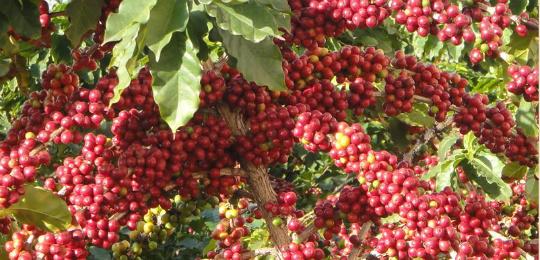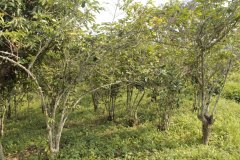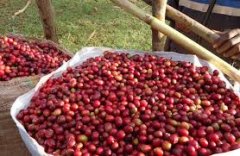The OLAM project in Ogu, Cameroon introduces Kemelon's unique description of washed coffee in volcanic lakes.
For professional baristas, please follow the coffee workshop (Wechat official account cafe_style)
This fully washed coffee comes from Ogu, Cameroon. Standing on the valley is Mount Oku Mount, which covers an area of 3011 acres, the second highest peak in West Africa. Oku is a subdivision of the Bui subzone in northwest Cameroon. Coffee grows between 1800 and 2200 and grows under orange and banana trees. Collect coffee and wash it with fresh spring water on the same day. Then dry on a raised bed. It is reported that the main varieties growing in Ogu were brought from Jamaica more than 70 years ago. It is now grown with a more active variety from the Indonesian province of Java and promoted by IRAD, a Cameroonian research institute. The exotic Kilum Forest was found that the world's famous white honey harvest and coffee pollination are mainly done by bees in this forest.

A stagnant volcanic lake sits at the top of the mountain, from which several springs of water gush to the villagers. The soil is mainly volcanic and tends to be slightly acidic. About 400 tons of washed Arabica are produced each year, and Osie is one of the most coffee-dependent villages in the northwest. Production is mainly small farmers, with farms ranging from 1 / 4ha to 3ha. Coffee grows on the slopes of Oku Mountain, ranging in height from 1700masl to 2200mas > l. Mainly small farmers, agricultural practice is basic. However, over the past six years, OLAM CAM SA has launched a coffee program to promote good agricultural practices.
The OLAM project covers three departments in the northwest region. This is in response to the decline in the production and quality of Arabica coffee in the region. Its goal is to improve livelihoods, ensure better quality and increase market access by increasing coffee production. The project adopts the farmer field school model. There are 94 registered farmers in Farmers' Field School. The Olympic Village is one of the main villages involved in the project, with about 450 members forming 12 farmers' field school groups.
Origin: Cameroon
Region: northwest region
Sub-region: Ogu
Treatment method: washing treatment method
Instructions: ripe cherries are carefully selected and washed on the same day, and then dried on a raised bed.

Coffee grade: FW A
Altitude: 1800-2200m
Variety: Cameroon Boyo
Flavor description: chocolate, molasses, BlackBerry, flower fragrance
Important Notice :
前街咖啡 FrontStreet Coffee has moved to new addredd:
FrontStreet Coffee Address: 315,Donghua East Road,GuangZhou
Tel:020 38364473
- Prev

Introduction of Colombian mocha coffee beans 2018 description of the latest flavor of mocha varieties
For professional baristas, please follow the coffee workshop (Wechat official account cafe_style). This coffee comes from the family-owned Hacienda La Pradera in Alatoca, Santander, Colombia. The manor is 100% organic and Rainforest Alliance certified, and coffee is grown between 1700 and 1900 meters. The family's coffee-growing tradition has improved the crop harvest for more than 30 years.
- Next

Why do they say East Timor coffee has devil's endings? What is devil's endings?
Professional barista exchanges Please pay attention to Coffee Workshop (Weixin Official Accounts cafe_style ) This is a FW-grade organic coffee that collects 23 families in Laco Village, Ai Lu, south of Emera and west of East Timor. Lacau's elevations range from 1500 - 1700 masl and include Hybrid de Timor (Moka) and Typica (Arabe). Pulping parchment fermentation 24-48
Related
- Does Rose Summer choose Blue, Green or Red? Detailed explanation of Rose Summer Coffee plots and Classification in Panamanian Jade Manor
- What is the difference between the origin, producing area, processing plant, cooperative and manor of coffee beans?
- How fine does the espresso powder fit? how to grind the espresso?
- Sca coffee roasting degree color card coffee roasting degree 8 roasting color values what do you mean?
- The practice of lattes: how to make lattes at home
- Introduction to Indonesian Fine Coffee beans-- Java Coffee producing area of Indonesian Arabica Coffee
- How much will the flavor of light and medium roasted rose summer be expressed? What baking level is rose summer suitable for?
- Introduction to the characteristics of washing, sun-drying or wet-planing coffee commonly used in Mantenin, Indonesia
- Price characteristics of Arabica Coffee Bean Starbucks introduction to Manning Coffee Bean Taste producing area Variety Manor
- What is the authentic Yega flavor? What are the flavor characteristics of the really excellent Yejasuffi coffee beans?

